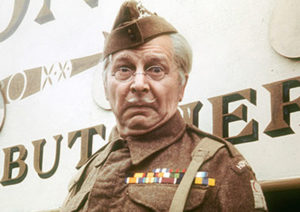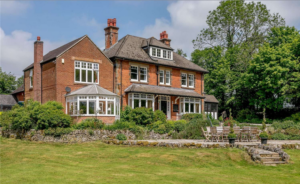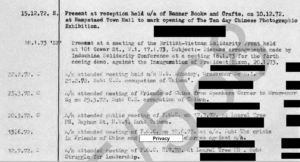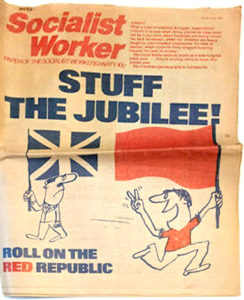UCPI Daily Report, 13 May 2022
Tranche 1, Phase 3, Day 5
13 May 2022
Witnesses:
Elizabeth Leicester (former member of the Workers Revolutionary Party)
Barry Moss (undercover officer 1968, manager 1980-82)
Today was the second day of live witness hearings in the Undercover Policing Inquiry’s current phase examining managers of the Special Demonstration Squad (SDS) 1968-82.
The first testimony came from Liz Leicester, a former member of the Workers Revolutionary Party.
We also heard the testimony of a central figure in the spycops scandal, Barry Moss, who was an undercover officer in 1968 and then a senior officer responsible for the SDS between 1980 and 1982.
He went on to be Commander of Special Branch during the time that undercover officer Peter Francis was deployed against the family of murdered teenager Stephen Lawrence’s, and several officers under his management had sexual relationships whilst undercover. Frustratingly, questions today were limited to the Tranche 1 era – 1968-82 – by the Inquiry’s Chair, Sir John Mitting.
Elizabeth Leicester (former member of the Workers Revolutionary Party)

Dad’s Army actor Clive Dunn was among the thespian members of the Workers Revolutionary Party in the 1970s
First we heard from Elizabeth Leicester, who was part of the Workers Revolutionary Party (WRP) – originally known as the Socialist Labour League (SLL).
Leicester lived at White Meadow (aka The Red House), the WRP’s training centre in Derbyshire, between 1975-1978. Her former husband and WRP comrade Roy Battersby was a film director, and also a prominent member of the party.
We heard about Leicester’s involvement in the SLL – she worked in its Clapham office, on its paper, the ‘Workers Press’. Her and her husband were both part of the outer London branch. It was an unusual branch: is well known that Corin and Vanessa Redgrave were members but other prominent actors such as Clive Dunn, Spike Milligan [MPS-0747833] and Frances de la Tour were also involved.
Leicester said the open aim of the WRP was to establish a socialist state. It had a chain of bookshops and a film production company. Like yesterday’s witness Lindsay German, Leicester said that the WRP did not envision themselves being a vanguardist organisation – it was up to the majority of the working class to have a revolution.
She described the many strikes of the 70s, a “real upsurge of workplace democracy” – and made it clear that “we worked as genuine trade unionists” – rather than covertly infiltrating those unions. While they were inspired by the Russian revolution, the WRP used constitutional, non-violent and lawful means to advance their aims.
Amusingly, part of the WRP election manifesto was read out, with an unfortunate slip-up by the Inquiry’s lawyer – who accidentally said ‘conservative’ instead of ‘communist'(!)
WHITE MEADOW

White Meadow, aka The Red House. The WRP’s training centre in the 1970s
Initially purchased by the actor Corin Redgrave supposedly as a “drama and arts centre”. Leicester is asked whether that was ever its real purpose – or was it always going to be a college of Marxist education? She said that the aim was to protect it from adverse attention from fascists – and not to alarm the locals.
A police raid took place at White Meadow on 27th September 1975. This seems to have resulted from a meeting between The Observer Newspaper and Special Branch officers a couple of days previously [UCPI0000034744]. Leicester also recalled that an aerial photo appeared on the front on the Daily Telegraph – presenting the WRP as a serious threat to the public. The WRP sued the editor of The Observer for libel.
A seven-page Special Branch report probably written by ‘Michael Scott‘ (officer HN298, 1971-76) [UCPI0000012240] gives many details on the White Meadow Centre. Dated 25 February 1976, the report describes the founding of White Meadow the previous summer. It also claimed 900 students had attended the centre in the previous six months. Leicester said that the figure was massively exaggerated.
Additionally, the report lists several financial costs associated with the centre. Leicester says there is no way an undercover could have gleaned that information by attending the centre – and suggest the intelligence might have come from ‘Peter Collins‘ (officer HN303, 1973-77) who also infiltrated the party.
SECURITY MEASURES
Understandably, after the police raid, security measures were increased. Leicester and Battersby searched students on entrance to the centre after the police raid. They also worried about electronic surveillance and found many listening devices. During a summer camp set up by the SLL, there was a concern about a police raid. For security Leicester says she took the membership and financial docs to London with her.
Leicester said the measures were to guard against both state and fascist infiltration. Some of the students who attended their centre were from Greece, Portugal and Spain all of which had fascist dictatorships in the early 1970s.
CONCLUSION
The Special Branch report also listed the subjects taught. As you would expect, these revolved around classic Marxist texts. Leicester jokingly wondered how the undercover got on with “Lenin, Vol. 38 – not an easy read!”
Leicester said it was outrageous that her family home – and two children – were spied upon. The WRP were not a public order threat – and the police knew that – and they were spied upon anyway.
She notes that ‘Michael Scott’ (HN298), whose time at White Meadows was described by a senior officer as ‘his swan song’, was ordered not to go there but went anyway. He could have dropped out of attending without raising any suspicion, raising a glaring question Leicester asked aloud:
“So why did he choose to go there?”
Leicester finished by saying that it’s a shame that the WRP are not core participants at the Inquiry, and that Collins’ infiltration is not being investigated more. Former WRP members don’t have the full disclosure they deserve.
Witness statement of Elizabeth Leicester
Barry Moss (undercover officer 1968, manager 1980-82)
BACKGROUND
Barry Moss was one of the first undercovers of the Special Demonstration Squad (SDS), deployed for three months in 1968. He used the cover name ‘Barry Morris’. This period was covered in his first witness statement.
On leaving the SDS he took part in the accelerated promotion scheme, moving around all the main Special Branch squads. He also spent time outside of Special Branch in CID before returning in February 1980 to become Detective Chief Inspector (DCI) for the SDS, where he remained for a year before being promoted to Superintendent of ‘S Squad’ with oversight of the SDS.
After a period (1990-1991) as a uniformed Commander with responsibility for North East London, he became a Commander of Special Branch. In 1995 he was Commander of Operations which included responsibility for the SDS. In 1996 he became overall head of Special Branch until he retired in 1999. He helped establish the National Public Order Intelligence Unit, the second major spycops unit after the SDS.
In his capacity as head of Special Branch, Moss gave evidence to the Ellison Inquiry into police corruption surrounding the murder of Stephen Lawrence. He told Ellison that he had no knowledge of the workings of the SDS, a claim that, given his extensive career with the unit, cannot possibly be true.
However, the Inquiry’s Chair, Sir John Mitting, has refused to allow questions about this later period in this evidence, which deals only with his role as an SDS DCI (in the Inquiry’s Tranche 1 Phase 3 period, ie 1968-82).
LEGALITY OF UNDERCOVER POLICING

David Barr QC
The evidence began with David Barr, Counsel to the Inquiry, diving straight into issues raised in the opening statement of Charlotte Kilroy, QC, on behalf of women deceived into relationships by spycops.
Barr wanted to know about the training Moss had received – any on race or sexual equality, or on human rights more generally? None.
What about the powers of entry which police officers had? Moss received some training on this at the beginning of his police career and later while with CID.
Barr sought to explore what grasp a senior commander such as Moss had of basic policing principles. Moss struggled quite a bit to answer on this. There was no sense he had ever given much thought to the reasons for doing things, particularly their necessity or purpose, let alone their lawfulness.
The complete lack of training or guidance given to managers and undercover officers was a recurring theme throughout the day, as was an utter disrespect for, and lack of interest in, the law. It was only from what he had picked up from the Inquiry that he realised they had been breaking the law.
Barr looked at intelligence reports Moss had authored as an undercover officer, including a meeting of Maoists in a private home. Moss admitted he was not given any guidance on the legality of entering a home without a warrant.
“I think my understanding of the rules in normal work would have been fairly clear. I had no idea that this may have been illegal, as I’ve seen from Ms Kilroy’s submission earlier to this Inquiry.
“We were there to garner information (…) it might have been illegal in one way or another, I did not think of it.”
When pressed, Moss admitted there was no consideration given to its legality at all.
INTERPRETING REPORTS & OTHER MATERIALS
The Inquiry also addressed time Moss spent serving with C Squad, the part of the Met’s Special Branch that dealt with left wing activists.
This included an important point where he interpreted the annotations next to dates on the Special Branch Registry File index of Diane Langford, as coming from an old government classification scheme.

Diane Langford’s Special Branch Registry File index
He was able to say C meant Confidential, S was Secret and SP was Secret ‘Pink’ – meaning material accessible to anyone in Special Branch. He also described a further category, Secret ‘Green’, for top secret material.
He admitted that while at C Squad he had written several threat assessments on demonstrations and described the process by which these were constructed. Asked if he could tell if intelligence reports feeding into the assessment came from the SDS, he replied:
“Yes, the preamble usually gave an indication that it came from SDS, if you understood the system.”
When Barr returned to this point later on, Moss took him through how the intelligence gathered – such as lists of members – fed into constructing a threat assessment. If a group or branch was organising a demonstration, the starting basis was how many people were they, what sort of people were they and what links did they have to bring in other groups or branches which would bring in numbers.
Barr also had Moss explore the SDS’s relationship with C Squad, the part of Special Branch which oversaw operations against left wing groups.
From Moss’ evidence it is clear that C Squad was very important in terms of setting the agenda for the SDS. This included guidance on which groups should be targeted. Moss confirmed that C Squad was as a key ‘customer’ of SDS intelligence, and the main conduit for passing SDS reports on to the Security Service.
There was no regular contact with C Squad, but there did not need to be as, given their long relationship, the SDS was pretty much producing what they wanted anyway. Knowing what to report as an SDS officer was developed for the most part through having been an officer in the wider Special Branch.
MANAGING THE SDS
Moss took over from Mike Ferguson (a former undercover himself) as Detective Chief Inspector (DCI) in what appears to have been an abrupt transition. He received no handover from Ferguson and had to find his own way. He learned on the job, reading reports by undercovers, and relied heavily on his deputy, Detective Inspector Trevor Butler, who had also been deputy under Ferguson, and who Moss described at one point as a “mentor”.
He also relied heavily on his brief time as an undercover, 12 years previously. Asked whether he knew about misbehaviour by a number of previous undercovers, he denied knowing anything other than that Rick Clark had been exposed.
LITTLE CHANGE
Mostly Moss continued with practices that were already in place. The only change of note is that he considered the unit had too much coverage of the Socialist Workers Party (SWP) and when he became manager he directed a newly deployed undercover (‘Malcolm Shearing‘, officer HN19) to look at a different milieu.
He accepted it was up to him to review the justification of deployments but it was hard, because undercovers were deeply entrenched in groups and difficult to move around. He gave very little consideration to the legality or justification, or alternative ways of gathering the intelligence. As far as he was concerned the system he inherited was a good one:
“The SDS already existed, so why not use it?”
He did not assess the level of intrusion against what was actually produced. As far as he was concerned, it all served some purpose or another.
Asked if operational security was of paramount importance he replied:
“Yes, no other organisation in the country, or even in the world was doing what we were doing.”
This is ironic, given the extensive propaganda criticising political policing in Eastern Bloc countries. There were clearly many agencies doing exactly what they were doing, in dictatorships all over the world.

Socialist Worker, Queen’s silver jubilee edition, June 1977
He was firm that the primary reason for the SDS was to gather intelligence on public order issues, and the intelligence for the Security Service was ‘ancillary’, although he belied some of his points on public order by admitting that putting an undercover into the anarchist newspaper Freedom Press would have been a stepping stone to get to another group.
INTRUSIVE REPORTING
Barr took Moss through a number of reports that he had signed off, and was responsible for as head of the unit.
His response was a mixture of not remembering the details, shifting the responsibility to others – whether individual undercover officers he was overseeing, or the ‘customers’ of the SDS – C Squad, A8 (the Met department delaing with public order) and the Security Service.
Moss did not compile or assess reports, but did sign them off – well, sometimes at least. The reports were disseminated as C squad saw fit, he had no influence on that. The SDS approach was to hoover up as much intelligence as possible, which was to be considered and analysed by others.
In a few, very few, cases (such as a 1980 report on an individual who had just joined the SWP that included his job at the General Post Office, his address and bank account, the fact that he was gay and was an avid reader of Gay News), Moss reluctantly agreed that with hindsight he should have been more cautious in signing it off, as some reporting was not appropriate; but hey, those were different times.
Barr then pulled up a long report dated August 1980, about a woman, her activities, relationships, where she lived, and with whom, Barr read out a long quote:
“In the last week [she] has intimated that she wishes to fall pregnant again, and for this purpose has ceased to take ‘the pill’ on a regular basis. She is however, not quite sure at the present as to who will sire this latest socialist offspring.”
Discussing her political involvement the report says that such:
“would not include an interest in Irish orientated groups … as her main interest, culturally, politically and personally is with the black races and persons of similar ethnic origins”.
Barr asked Moss:
“You signed it, so you would have read it?”
Moss replied:
“Yes.”
And he did think the content was relevant, because this individual would probably ‘settle down’ and be less active in the ‘ultra left’ if she had another child – adding sexism to his racism.
Barr pressed on:
“Did you consider the tone appropriate?”
Moss started stuttering:
“I — I — I thought one of the sentences was — was a bit odd, and I’m not sure I’d — in — in today’s light — I haven’t got it in front of me any more — “
Although Moss said he understood that the tone of this report would be unacceptable now, he was very reluctant to accept that the extraordinary level of detail was inappropriate – insisting that such details were of relevance to the Security Service, and therefore he would pass them on.
STEALING DEAD CHILDREN’S IDENTITIES
Moss said that at the time, he didn’t consider if using the birth certificate of dead children was lawful or not, but he did not see any other way for the undercovers to obtain documents in their cover names. He left it to his officers to create their fake identities, saying he wasn’t personally involved in this himself.
Moss accepted there was a risk, as Richard Clark (officer HN297) had been confronted with the death certificate of Rick Gibson, the dead child whose identity he’d stolen. However he said he thought “the chances of it happening again were probably remote”, because this had only happened once.
FAR RIGHT
The far right were not infiltrated in the same way as the left wing groups.
The SDS did not target them, something Moss says he and Butler discussed, due to a policy decision from a higher level – “because they were too violent, and we were concerned what the officer may have to do to prove his credentials”.
RELATIONSHIP WITH THE SECURITY SERVICE
Moss describes a cordial, good relationship between the Special Demonstration Squad and the Security Service under his management. They had meetings every few months and they appeared to be genuinely grateful for the intelligence supplied, particularly the intelligence on the SWP who in the Security Service’s mind had replaced the Communist Party of Great Britain as the main subversive group. He wanted to be as helpful to the Security Service as possible, provided it did not cut across the public order mandate of the SDS.
In these hearings, and earlier ones, we had heard there was almost no formal training or guidance for undercover officers, but today Barr brought out a syllabus from 1979, for a Special Branch training course that ran over three weeks.
Later in his career Moss held responsibility for organising these courses for Special Branch officers from all over the country, which ran parallel with courses by the Security Service for their staff. In conjunction, they would provide lecturers for a number of topics.
He supposed that the Security Service would have liked to have even more influence over the SDS than they did, saying:
“if we could accede to their requests without detriment to ourselves, then we would oblige them… it wasn’t quite a two way flow of information – we probably gave them more than they gave us”.
Asked if undercover officers took risks in order to gather intelligence for the Security Service, he said he left it to his officers to judge whether the risk was worth it – the priority was to maintain their cover in the group. Much of the communication with the Security Service was mediated by C Squad.
The names of the groups being infiltrated were given to the Security Service. Moss at first claimed that the officers’ cover names would not have been shared, then admitted that this may have happened, claiming their real names certainly weren’t though.
SUBVERSION
Discussion of the Security Service led to a long and technical discussion about the definition of ‘subversion’. It was clear that Moss had given no serious thought to what it meant, and made a lot of assumptions.
The nearest he had to any training on this was during the Security Service induction session for junior Special Branch officers, when there was some discussion of what ‘subversion’ was.
It was pointed out that several Special Branch Annual Reports said SWP were not really a threat, he responded that the Security Service certainly saw them as subversive.
BLAIR PEACH
After anti-fascist Blair Peach was killed by police on a demonstration in April 1979, a police internal investigation identified the officers reponsible, yet none face any charges and the report remained secret. There was a concerted public campaign for truth and justice. As with so many similar justice campaigns, it was spied on by undercover police.
Moss maintained that the main reason for gathering intelligence on the Friends of Blair Peach was the potential risk to public order.
Barr asked about the SDS Annual Report for 1979 which said:
“The culmination of the virulent anti-fascist demonstrations was the death of the Anti-Nazi League supporter Blair Peach and the subsequent campaign against Police.”
Moss admitted that this was “unfortunately phrased” and came from “a rather defensive mindset”.
Barr pointed out that in his own witness statement, Moss had referred to “the SWP piggybacking on to Blair Peach’s death”.
As Peach was an SWP member, Barr asked “wouldn’t it be fairer to recognise that Blair Peach was one of their own?” and further enquired:
“Would you accept that this was a justice campaign which ultimately did secure some justice?
Moss replied:
“I would.”
Moss said the SDS never received any requests for intelligence on the Blair Peach campaign, or any other similar justice campaign. This didn’t stop them from indiscriminately hoovering it up anyway.
THE NATIONAL FRONT
The SDS Annual Report for 1980 shows that the counter demonstrations organised against the fascist National Front were a major theme when Moss was Head of SDS. He claimed there was
“always a matter of debate within the police service how far the police should go to facilitate free speech.”
Moss was of the opinion that “it was the Left that caused the disorder in those circumstances” – and in his dubious logic, he suggested they should be banned from demonstrating:
“So what I’m saying, in rather a lengthy way, is, if the National Front had just been allowed to demonstrate and the left wing hadn’t turned up, there probably wouldn’t have been any disorder, in my opinion.”
Barr asked:
“What would have happened if the left and right had been allowed to appear without a police presence?”
Moss was sure:
“Oh, it would have been mayhem.”
RELATIONSHIPS
Almost all of the officers who were deployed undercover were married, yet their cover identities were of single men. Moss said it never crossed his mind that this might increase the risk of sexual activity occurring.
Was there not a risk of undercovers forming such relationships to protect them from suspicion and enhance their cover stories? In Moss’s view, this would have been such a “silly thing to do” that they wouldn’t have contemplated it, so he never felt the need to give them any advice about this.
We heard about the conversations Moss had with his officers when he met them at the unit’s safe houses (twice a week) – to check in about their welfare and their work. They were able to bring up any issues and discuss anything they wanted. However it seems that Moss never brought up the issue of sexual relationships with them.
Barr took Moss through a long list of undercover officers who had, under his watch, got intimately involved with women they were spying on; officer HN21 (cover name not published), ‘Barry Tompkins’ (officer HN106), ‘Paul Gray’ (officer HN126), and ‘Phil Cooper’ (officer HN155). Moss said he’d had no inkling of any of this at the time.
We also heard about some significant contradictions in how the SDS dealt with relationship issues. ‘Jim Pickford’ (officer HN300) confessed to falling in love with an activist (who he later married), and was removed from the SDS in the 1970s.
We’d heard earlier about Moss’s feelings about a Special Branch officer who was known to have been unfaithful to his wife – by indulging in an affair with a civilian colleague in New Scotland Yard – who he blocked from joining the unit.
However, when an officer already inside the unit (‘Paul Gray’, HN126) decided to live with his affair partner, another police officer, in the Met’s married quarters, Moss didn’t have a problem with it.
He went so far as to pay a personal visit to the wronged wife of this officer, presumably to put pressure on to keep her quiet, as she’d threatened (in an anonymous letter) to spill the beans about the entire operation of the ‘Hairies’, as the spycops were known.
We heard more about ‘Phil Cooper’ (HN155), and his wife. Moss said he “did not treat her well”, and upon questioning, admitted that there was some kind of domestic abuse going on, and possible violence.
Did that not give him concerns about Cooper’s suitability as an SDS officer?
“It probably should have done – if it was physical, but I can’t remember if it was physical or mental, if I can use that word. He was a larger-than-life-character.”
That chilling apology for domestic abuse ended Day 4 of the current hearings.
Transcript and video of the day’s hearing (Elizabeth Leicester on screen, Barry Moss audio only)
The current round of Undercover Policing Inquiry hearings, focusing on Special Demonstration Squad managers 1968-82, continue until Friday 20 May.
